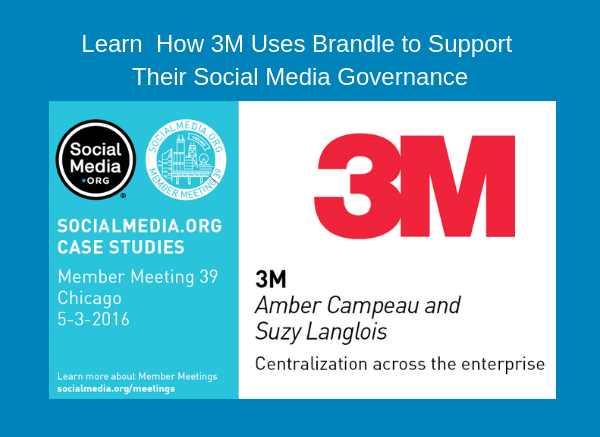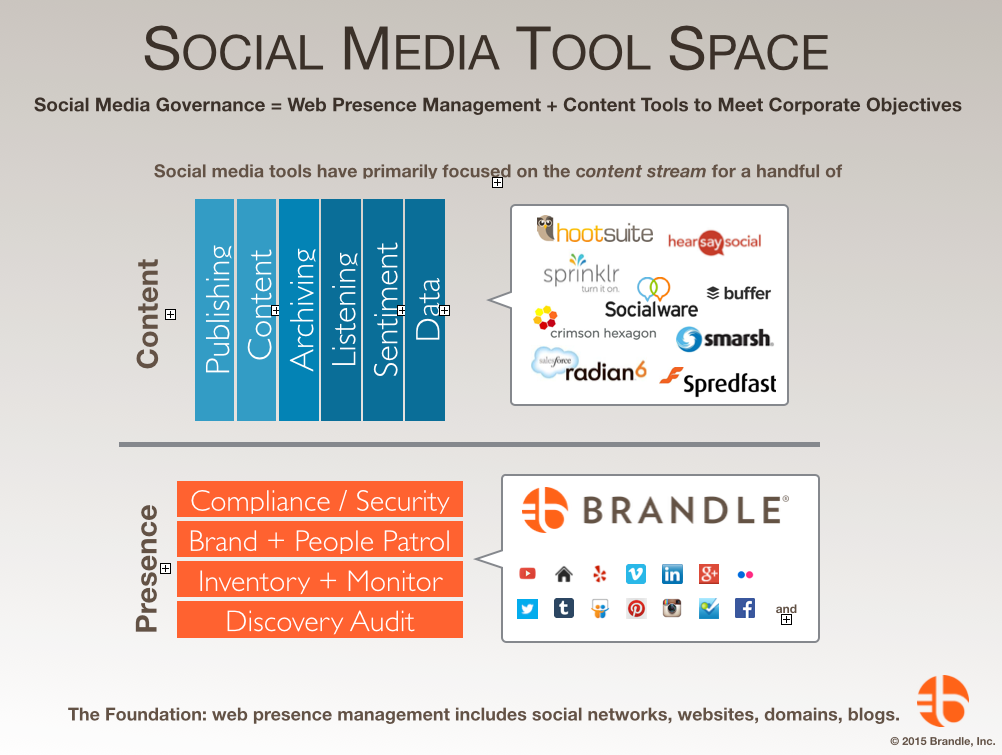
If you asked your colleagues in the marketing, PR, or IT departments "How big is our corporate web presence?”, would they give you a consistent answer? What if you included your colleagues over in legal, risk, and compliance? Would you start to get a consensus or would you just get more answers that don't agree?
According to a 2013 report by the Altimeter Group at least 13 different departments within the enterprise have a stake in the corporate social media presence alone. However, what each group imagines when they talk about corporate web presence may vary widely. Are they concerned about trademark protection (e.g. legal), or managing registrations for corporate domain names (e.g. IT), or all the product and campaign points-of-presence (e.g Marketing and PR)? It is even possible your colleague might alter her answer based on what she thinks you need to hear, due to your role.
Most businesses today lack a comprehensive and consistent inventory of their corporate web presence and that is partly because the world has been changing so quickly that few have had time to agree upon a common definition of "corporate web presence."
So, let's fix that.
WEB PRESENCE IS MORE THAN JUST MARKETING
This is the first of a three-part series on understanding web presence. In this article, we explore what makes up a corporate web presence. The second will explore web presence management as a discipline and the third will look at web presence management systems.
Let's get started by looking at the five (5) very important elements that make up the web presence of an enterprise:
1. Domain names
Domain names are the foundation of your web presence. Lose control of a domain name and not only might one or more of your websites go dark but employees may become unreachable by the public (e.g. via email) and web applications may stop functioning. The challenge is that most companies of any size have hundreds and often times thousands of domain names, many of them interdependent upon one another. Additionally, these domains are frequently registered by a variety of employees (current and past) to a variety of organizations using a multitude of email addresses.
Therefore, building and monitoring an inventory of domain names (and relevant registry information) is vital to ensuring a corporation's web presence remains online and functioning.
2. Websites and microsites
For an enterprise of any size, the company is likely to maintain multiple websites. While some "websites" are really just domain names providing alternative web addresses for one of the main corporate sites, it is very common for an enterprise to have websites (or microsites) for specific brands, products, regions, campaigns, teams, etc. These alternative sites are often created and managed by disparate teams and external agencies. It's also common for these secondary sites to be operating fairly independently from the team that maintains the primary website(s).
Therefore, it's important for a company not only to know its registered domains but to maintain an accurate inventory of actual sites hosting its web pages.
3. Social media
It goes without saying that the vast majority of businesses today have established a presence on social media. However, just like with domain names and websites, the enterprise is facing a proliferation of accounts on social media that often number in the hundreds, if not thousands! While many companies are still blind to the actual size of their social media footprint, a web presence discovery (possibly as part of a larger social media audit) will bring them to light. Just as with the domain names, the social media points-of-presence were created by a cadre of employees (current and past) using an array of user credentials and whatever information and branding was at their disposal at the time.
Therefore, a company needs to regularly search the social media platforms for new properties representing any of their business interests. Not only do these properties need to be included in the corporate inventory but the "owner" of each property needs to be identified, recorded, and the credentials secured. Many companies find that associating each point-of-presence with a product, brand, etc. it represents and the division or geographic region where it is utilized is also important.
If you are a business with brick-and-mortar presence, you also need to be aware that some social media networks (such as Facebook) will automatically create place pages for your local business. These points-of-presence should also be inventoried–possibly merged–and tracked since consumers often engage with your company via these pages.
4. User-generated pages
So far, the focus has been on owned media, or properties under the exclusive control of the business. However, there is a wide range of other owned and unowned user-generated pages on the web which may concern the enterprise. Examples of these include review sites, wiki pages, and profile pages where either the company or key employees are represented (e.g. an industry-specific blogging site or a membership community).
Whether for brand protection, compliance or any other form of risk mitigation, keeping track of these pages is important to the enterprise, especially in regulated industries.
5. Web addresses (URLs)
An area that is often overlooked is the wide range of web addresses or URLs which are used to weave the corporate web presence together. It is standard practice for employees (and others) to provide web addresses which point to other web properties as they create or update a profile for a point-of-presence on the web. While using an out-dated or dead link may hurt the professional image of the brand, referencing a web property that is unofficial and/or outside the scope of corporate governance can introduce unnecessary risks.
Therefore, it should be standard practice to periodically review which web addresses are in use and by which web properties in your inventory.
Many stakeholders, one inventory
As you can see, a corporate web presence (aka brand presence) is quite the multi-headed beast. To tame it one must get control of each head which could come back to bite you. Unfortunately, too many businesses still take a fragmented and disjointed approach toward inventorying their web presence but it does not have to be that way.
As we've already described, each of the various types of web presence may itself have multiple stakeholders. On top of this, it is entirely possible that legal is trying to "own" domains, while IT has the web servers and some part of marketing "owns" social media. However, this does not mean they can't be working from the same list of properties; a single system can be used to discover, inventory and monitor the corporate web presence. Having one comprehensive system allows the company to maintain one master inventory, with each stakeholder taking ownership of his or her area of responsibility.
It should be noted that when we say "own", we are not talking about who has the rights to control the content (e.g. marketing or PR). A web property may have many "owners" depending on the function performed (e.g. asset management, content production, compliance review, etc). A web presence management system can help you track all those stakeholders for a particular web presence asset but each and every property should have an asset owner who ensures the property is secure and free of risk.
In the next article we will expand upon some of these concepts as we discuss corporate web presence management.
CONCLUSION:
It's time to say goodbye to the ad hoc and disjointed set of spreadsheets and other disparate tools which leave gaps and expose the company to various forms of risk. With a unified view of web presence, the enterprise can bring all stakeholders together to track domain names, websites, social media and other forms of web presence and thus have a complete picture of where and how the enterprise is represented on the web.








